
NGC 4567 and NGC 4568 are a set of unbarred spiral galaxies about 60 million light-years away in the constellation Virgo. They were both discovered by William Herschel in 1784. They are part of the Virgo Cluster of galaxies.

NGC 4492 is a spiral galaxy located about 90 million light-years away in the constellation Virgo. NGC 4492 was discovered by astronomer William Herschel on December 28, 1785. It was rediscovered by astronomer Arnold Schwassmann on January 23, 1900, and was listed as IC 3438. NGC 4492 lies in the direction of the Virgo Cluster. However, it is not considered to be a member of that cluster.

NGC 4498 is a barred spiral galaxy located about 50 million light-years away in the constellation Coma Berenices. NGC 4498 was discovered by astronomer William Herschel on March 21, 1784. NGC 4498 is a member of the Virgo Cluster.

NGC 4540 is a spiral galaxy with type 1 Seyfert activity located about 64 million light-years away in the constellation Coma Berenices. NGC 4540 was discovered by astronomer William Herschel on March 21, 1784 and is a member of the Virgo Cluster.

NGC 4659 is a lenticular galaxy located about 54 million light-years away in the constellation Coma Berenices. NGC 4659 was discovered by astronomer William Herschel on April 12, 1784 and is a member of the Virgo Cluster.

NGC 4222 is an edge-on spiral galaxy located about 60 million light-years away in the constellation Coma Berenices. It was discovered by astronomer William Herschel on April 8, 1784 and is often misidentified as IC 3087. NGC 4222 is a member of the Virgo Cluster and is a companion of NGC 4216 which lies about 180,000 ly (56 kpc) away. Despite this, the two galaxies are not interacting.
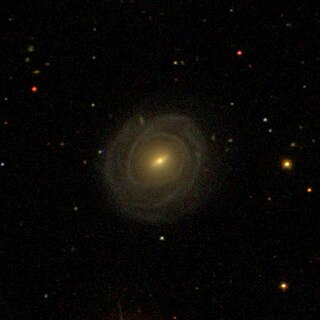
NGC 4326 is a barred spiral galaxy with a ring located about 330 million light-years away in the constellation Virgo. It was discovered by astronomer William Herschel on April 13, 1784, who described it as "vF, S, R, bM, 1st of 3". It is a large galaxy, with a diameter of around 200,000 ly (61 kpc) making it nearly twice the size of the Milky Way. NGC 4326 is also classified as a LINER galaxy. Despite being listed in the Virgo Cluster catalog as VCC 623, it is not a member of the Virgo Cluster but instead a background galaxy.
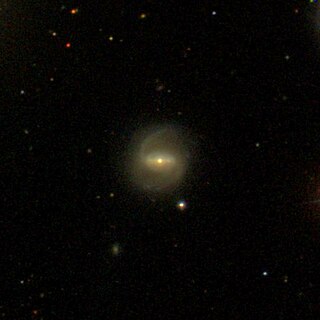
NGC 4333 is a barred spiral galaxy with a ring structure located about 330 million light-years away in the constellation Virgo. It was discovered by astronomer William Herschel on April 13, 1784, who described it as "F, pS, R, bM, 2nd of 3". NGC 4333 is also classified as a LINER galaxy. Despite being listed in the Virgo Cluster catalog as VCC 637, it is not a member of the Virgo Cluster but instead a background galaxy.
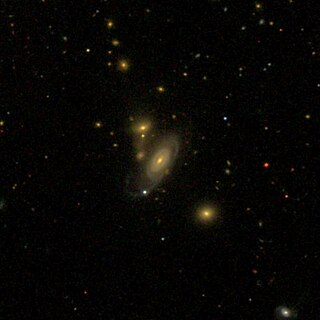
IC 4223 is a spiral galaxy located in Virgo constellation. The galaxy is located 684 million light-years away from the Solar System and was first discovered by Guillaume Bigourdan, a French astronomer, who saw it on April 12, 1899. Its diameter is around 120,000 light-years.

IC 3971 is a spiral galaxy located approximately 1 billion light-years away from the Solar System, in the constellation of Coma Berenices. It was first discovered in January 1904 by German astronomer Max Wolf. According to SIMBAD database, it is a LINER type galaxy with an active nucleus.

IC 3625 is a lenticular galaxy located in the constellation of Virgo, 990 million light-years away from the Solar System. With an apparent size of 0.75 by 0.55 arcmin, IC 3625 has an diameter of 200,000 light years, making it twice the size of the Milky Way. The object was discovered by American astronomer, Royal Harwood Frost on May 10, 1904. Despite listed in the Virgo Cluster catalogue as VCC 1799, it is not a member of the Virgo Cluster but instead a background galaxy.

IC 5337 or JW100, is a spiral galaxy located 800 million light-years away from the Solar System in the constellation of Pegasus. It is probably gravitationally bound to IC 5338, the brightest cluster galaxy in Abell 2626. IC 5337 is a jellyfish galaxy, mainly due to dynamic stripping pressure. Star-forming gas are thrown about, as the galaxy penetrates through the thin gas layer and causing them to drip from the galaxy's disc, giving it its unique appearance of a cosmic jellyfish. In the image, other galaxies can be seen in the background.

IC 3528 is a Seyfert 1.5 type spiral galaxy with X-ray emission located 660 million light-years away in the constellation of Coma Berenices. It lies near to spiral galaxy NGC 4540, although the two of them are quite far. The object was discovered by Royal Harwood Frost on May 7, 1904. Although listed as a member in the Virgo Cluster Catalogue as VCC 1593, it is not a member of the Virgo cluster but a background galaxy.
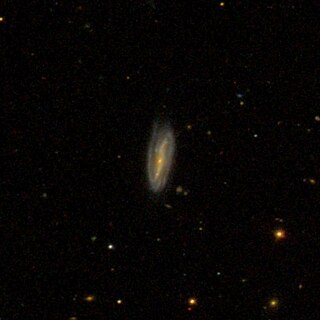
IC 3505 is a barred spiral galaxy located 640 million light-years away from the Solar System in the Coma Berenices constellation. With an apparent size of 0.95 by 0.35 arcmin, IC 3505 has an estimated diameter of 170,000 light-years, making it slightly larger compared to the Milky Way. It is categorized as a LINER galaxy with an active galactic nucleus emitting weak emission-lines.
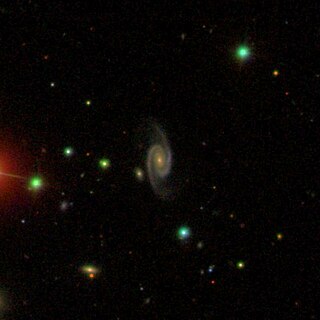
IC 3053 is a type Sab barred spiral galaxy with a ring located in the Coma Berenices constellation. The galaxy lies 720 million light-years from the Solar System and has an estimated diameter of 180,000 light-years meaning the galaxy is much larger compared to the Milky Way. IC 3053 was first discovered by Royal Harwood Frost on May 7, 1904. Despite listed in the Virgo Cluster Catalogue as VCC 95, it is not a member of the Virgo Cluster due to its high redshift and instead a background galaxy.
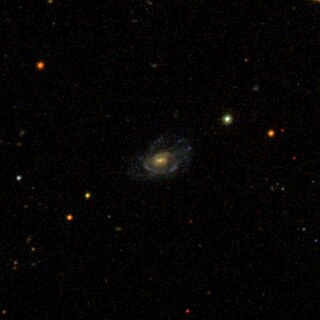
IC 3038 is a type Sab spiral galaxy located in the Virgo constellation. It is located 940 million light-years from the Solar System. The galaxy has an approximate diameter of 220,000 light-years, thus making it larger compared to the Milky Way. IC 3038 was found by Royal Harwood Frost on 7 May 1904. It has an apparent magnitude of 16p and located at right ascension of and declination. Although listed in the Virgo Cluster catalogue as VCC 57, it is not part of the Virgo Cluster, but instead a background galaxy.

IC 3246 known as PGC 40202, is a barred spiral galaxy with a ring located in the Virgo constellation. It is situated 1.13 billion light-years away from the Solar System and was discovered by Friedrich Karl Arnold Schwassmann on September 14, 1900. IC 3246 has a surface brightness of 23.6 magnitude/arc seconds and located at right ascension and declination respectively.
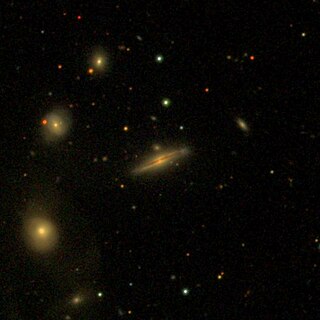
IC 1192 is an edge-on barred spiral galaxy located in Hercules. It is located 543 million light-years from the Solar System and has a diameter of approximately 90,000 light-years. IC 1192 was discovered by Stephane Javelle on August 13, 1892. It is a member of the Hercules Cluster.

IC 3078 is a spiral galaxy with a ring structure located in Virgo. Its redshift is 0.066148, meaning IC 3078 is located 905 million light-years from Earth. With an apparent dimension of 0.50 x 0.5 arcmin, IC 3038 is about 133,000 light-years across. It was discovered by Royal Harwood Frost on May 7, 1904 and is listed in the Virgo Cluster catalogue as VCC 174. However, it is not a member of the Virgo Cluster, but instead a background galaxy.

IC 3447 is a type Sc barred spiral galaxy located in the constellation Virgo. It has a redshift of 0.092479, which means IC 3447 is 1.27 billion light-years from Earth, making it one of the furthest objects in the Index Catalogue. The galaxy has apparent dimensions of 0.30 x 0.3 arcmin, which means IC 3447 is 111,000 light-years across. It was discovered by Royal Harwood Frost on May 10, 1904.




















